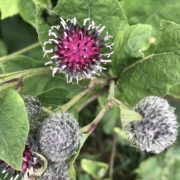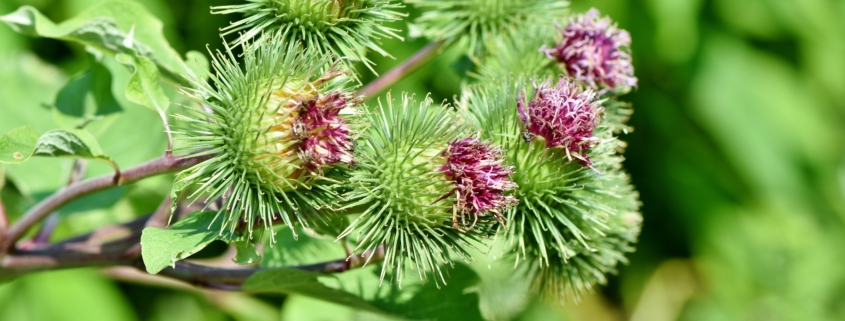Burdock
As we transition into Autumn our herbal allies can help assist our body and minds and allow us to stay grounded during times of change. Our ally, Burdock, is nurturing and moistening and a great ally to help us move from the summer season into fall.
 BOTANICAL NAME: Burdock (Arctium lappa)
BOTANICAL NAME: Burdock (Arctium lappa)
COMMON NAMES: Lappa, Gobo, Fox’s Clote, Thorny Burr, Beggar’s Buttons, Love Leaves, Philanthropinum, Personata, Happy Major, Clot-Bur.
FAMILY: Asteraceae
PARTS USED: Root, stalk, leaves, seeds
DESCRIPTION: Burdock is native to Europe and Asia but has now naturalized in North America and Australia. It has large wavy leaves and round heads of purple flowers. It is enclosed in a globular involucre (a series of bracts beneath or around a flower or flower cluster) of long stiff scales with hooked tips, the scales being often interwoven with a white, cottony substance. The whole plant is a dull, pale green, the stem about 3 to 4 feet and branched, rising from a biennial root. The lower leaves are very large, on long, solid footstalks, furrowed above, frequently more than a foot long heart-shaped and of a gray color on them under surfaces from the mass of fine down with which they are covered. The upper leaves are much smaller, more egg-shaped in form and not so densely clothed beneath with the gray down.
The plant varies considerably in appearance, and by some botanists, various subspecies or even separate species have been described, the variations being according to the size of the flowerheads and of the whole plant, the abundance of the whitish cotton-like substance that is sometimes found on the involucres, or the absence of it, the length of the flower stalks, etc. The flowerheads are found expanded during the latter part of the summer and well into the autumn: all the florets are tubular, the stamens dark purple and the styles whitish. The plant owes its dissemination greatly to the little hooked prickles of its involucre, or burrs, which adhere to everything with which they come in contact and attach themselves to coats of animals which can carry them to a distance.
Burdock is a biennial herb which means that it grows roots and leaves the first year and the second year sends up its flowering stocks and flowers and sets seed, after which the plant dies.
HABITAT/HARVESTING/ PROPAGATION: Burdock is currently cultivated in many countries around the world. Arctium is often found growing along roadsides, in open fields, and abandoned lots. In the first year of growth the leaves can be harvested and used as a food plant or in herbal preparations. In the Autumn of the first year the root is dug and also used as a food or in herbal preparations. Burdock root can be very hard to dig up as the root can grow down to 3 ft in depth! Burdock also tends to position itself in rocky areas with the roots twisting around rocks in the soil making it extra hard to dig up the whole root. In the second year the stalks and flowers/seeds can be harvested and used in food or herbal preparations. Sometimes the root is also harvested in the early spring of the second year before the plant begins to set flowers.
The seeds of A. lappa are used in TCM, under the name Niupangzi and are harvested at maturity in the fall of the second year’s growth. The seeds need to be stored in a dry and cool place.
ENERGETICS AND TASTE: Cooling, moistening, nourishing, bitter, sweet, oily (root); seed is warm, sweet, bitter, pungent, and diffusive.
TISSUE STATE: Dry/atrophy, Stagnation/torpor
CONSTITUENTS: Inulin (45-50%), mucilage, sugars, Lappin-a, fixed and volatile oils, tannic acid, protein, minerals, vitamins, lignans (arctigenin, arctiin, matairesinol), carbohydrates, pectin, caffeic acid derivatives chlorogenic acid, isochlorogenic acid1
SOLUBILITY: Water, alcohol, oil, glycerin
ACTIONS AND PROPERTIES: Alterative, diuretic, diaphoretic, demulcent, anti-scorbutic, hepatic, anti-mutagenic, aperient, immunostimulant, anti-inflammatory
USES AND INDICATIONS: The root is one of the best blood purifiers. Burdock cools and calms skin conditions such as eczema, psoriasis, rashes, boils and burns. It is also effective at easing joint conditions such as rheumatism, arthritis and gout. Burdock aids liver, gastrointestinal and kidney function, all of which are important for skin health and blood purification. It is also a superior strengthener of the immune system, and useful for chronic fatigue or suppressed immune systems. It is said to inhibit tumor growth and the formation of cancerous cells and protects the lungs and DNA from radiation damage. Overall, burdock binds and removes heavy metals and chemicals. In addition, it aids in replenishing intestinal flora after a round of antibiotics or Candida/yeast overgrowth.
Burdock root contains high amounts of inulin and mucilage. This may explain its soothing effects on the gastrointestinal tract. Bitter constituents in the root may also explain the traditional use of burdock to improve digestion. Additionally, burdock has been shown to reduce liver damage in animal studies.4 This has not been confirmed in human studies, however.
The high inulin content makes Burdock a suitable food or nutritive medicine for persons with sugar problems. Burdock root oil extract, also called Bur oil, is popular in Europe as a scalp treatment applied to improve hair strength, shine and body, help reverse scalp conditions such as dandruff, and combat hair loss.
An infusion of the leaves is useful to impart strength and tone to the stomach, for some forms of long-standing indigestion. When applied externally as a poultice, the leaves provide relief to bruises and inflamed surfaces generally. Burdock leaves are used by some burn care workers for pain management and to speed healing time in natural burn treatment. Burn care workers hold that it eases dressing changes and appears to impede bacterial growth on the wound site and that it also provides a great moisture barrier.
From the seeds, both a medicinal tincture and a fluid extract are prepared, of benefit in chronic skin diseases. The infusion or decoction of the seeds is employed in edema, especially in cases where there is co-existing derangement of the nervous system and is considered by many to be specific for all affections of the kidneys. The seeds are also antibacterial and used in TCM to expel wind heat, remedy sore throats, irritating coughs, tonsillitis, colds and influenza.
Because of Arctium’s moistening, cooling, and alterative effects on the body, it is a great herb to work with as we transition from the hot months of summer into the cooler and dryer days of Autumn. Burdock can help move trapped heat from the summer season out of the body. Autumn months can often be windy and dry and Arctium can help keep us grounded and moisturized as we move through this season. Burdock will help keep our immune systems strong as we begin to face more viruses and bacteria in the upcoming colder months.
Five main uses:
- Blood purification
- Aids digestion, improving liver, kidney and gastrointestinal function
- Stimulates bile production
- Poultice to remedy trauma impact: bruising, inflammation, impede bacteria growth
- All affections of kidney function
CONTRAINDICATIONS: None has been reported, although a gentle approach with this herb is advisable since it can be a powerful detoxifier in some individuals.
PREPARATION AND DOSAGE: Soluble in water, alcohol, and glycerin
Infusion: 2 tsp dried seed: 10 fl oz hot water, decoct 15 minutes, steep 30 minutes. Drink 1-3 cups/day
Tincture: Fresh root or seed (1:2, 95% alcohol; Dried root or seed (1:5, 50% alcohol) 1-5 mL 3x/day
Glycerite: Dried root (1:5) 2-10 mL 2x/day.
Capsule: 1,000-3,000 mg, 1-2x/day
HOMEOPATHIC/FLOWER ESSENCE USE: In homeopthay, Burdock is very important in skin therapeutics. Eruptions on the head, face, and neck; pimples; acne. Styes and ulcerations on the edge of the eyelids. Profuse and frequent micturition. Crops of boils and styes. Energetically in a flower essence can be helpful when you are caught up in deep old anger, especially if the anger is directed at someone, usually an authority figure. Although the anger may be triggered by a current person or situation, the origin for this quality of anger is from a wound earlier in this life or a past life. This anger may also be related to an experience of grief or loss.
ETHNOBOTANY/HISTORY/FOLKLORE: The name of the genus, Arctium, is derived from the Greek arktos, a bear, in allusion to the roughness of the burs, lappa, the specific name, being derived from a word meaning ‘to seize.’ Another source derives the word lappa from the Celtic llap, a hand, on account of its prehensile properties. The plant gets its name of ‘Dock’ from its large leaves; the ‘Bur’ is supposed to be a contraction of the French bourre, from the Latin burra, a lock of wool, such is often found entangled with it when sheep have passed by the growing plants. Burdock was written about by Shakespeare and Tolstoy. After taking his dog for a walk one day in the early 1940s, George de Mestral, a Swiss inventor, became curious about the seeds of the burdock plant that had attached themselves to his clothes and to the dog’s fur. Under a microscope, he looked closely at the hook-and-loop system that the seeds use to hitchhike on passing animals aiding seed dispersal, and he realized that the same approach could be used to join other things together. The result was Velcro.
REFERENCES:
- A Modern Herbal: http://www.botanical.com.
- Making Plant Medicine, Richo Cech.
- The Practice of Traditional Western Herbalism, Matthew Wood.
- Witches Heal, Billie Potts.
- Herbal Rituals, Judith Berger.
- Tree Frog Farm
- New Manual of Homeopathic Materia Medica with Repertory, William Boericke.
- Herbal PDR, Medical Economics Company Inc., Montvale, NJ. 2001.
- Cook, WM. The Physio-Medical Dispensatory: a Treatise on Therapeutics, Materia Medica and Pharmacy. Eclectic Medical Publications, Sandy, OR 1985 p.
- Felter HW, Lloyd JU. King’s American Dispensatory, 18th ed. Eclectic Medical Publications, Sandy, OR 1983 p.
- Mills, S. and Bone, K. Principles and Practice of Phytotherapy. Churchhill Livingstone, New York, NY. 2000
- Lininger et al: Healthnotes, Clinical Essentials, Prima Publishing, Rocklin, CA. 2001.
- Planta Medica 1990; 56:659
- Brinker, Francis ND. Herb Contraindications and Drug Interactions, 2nd ed. Eclectic Medical Publications, Sandy Oregon 1998. p. 45
***This article is for educational purposes only. It is not intended to diagnose, treat, prevent or cure any disease.***



